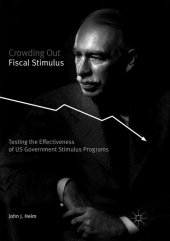 Neuerscheinungen 2018Stand: 2020-02-01 |
Schnellsuche
ISBN/Stichwort/Autor
|
Herderstraße 10
10625 Berlin
Tel.: 030 315 714 16
Fax 030 315 714 14
info@buchspektrum.de |

John J. Heim
Crowding Out Fiscal Stimulus
Testing the Effectiveness of US Government Stimulus Programs
Softcover reprint of the original 1st ed. 2017. 2018. xxi, 272 S. 5 Farbabb. 210 mm
Verlag/Jahr: SPRINGER, BERLIN; SPRINGER INTERNATIONAL PUBLISHING 2018
ISBN: 3-319-83410-X (331983410X)
Neue ISBN: 978-3-319-83410-8 (9783319834108)
Preis und Lieferzeit: Bitte klicken
This book presents overwhelming evidence that US government stimulus programs over the past fifty years have not worked. Using the best and most modern econometric testing models, it applies 228 separate hard science tests to examine the effects of different stimulus models that should, in theory, have shown positive results. By testing every possible alternative interpretation, starting with one time period and then retesting in three additional time periods, this definitive study finds that even when favoring pro-stimulus Keynesian models, public financing through government tax cuts and spending increase programs is more likely to drive down - or "crowd out" - as much private sector spending as it stimulates in the public sector.
1. Introduction 2. Theory of Crowd Out 3. Literature Review 4. Methodology 5. Test Results: Consumer Spending and Borrowing Models (1 Variable Deficit) 6. Test Results: Investment Spending and Borrowing Models (1 Variable Deficit) 7. Test Results: Consumer Spending and Borrowing Models (2 Variable Deficit) 8. Test Results: Investment Spending and Borrowing Models (2 Variable Deficit) 9. Are Findings of 1 and 2 Variable Consumer and Investment Deficit Models Consistent?
10. Effects of Stimulus Programs on GDP, Net of Crowd Out Effects 11. Dynamic Effects 12. Alternatives to Financing Stimulus Programs with Domestic Borrowing 13. A Note on the Disposable Income Variable in the Consumption Models 14. Do Crowd Out Effects Differ in Recessions and Nonrecession Periods? 15. Does the Gale/Orszag Hypothesis Explain Tax and Spending Effects Better in Recession than Nonrecession Periods? 16. Summary of Findings and Conclusions
John J. Heim is Visiting Professor at University of Albany-SUNY, and retired Clinical Professor of Economics at Rensselaer Polytechnic Institute, both in New York, USA.


